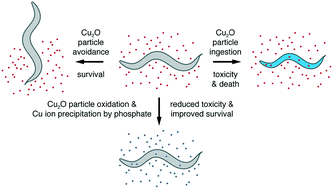Identification of toxicity effects of Cu2O materials on C. elegans as a function of environmental ionic composition†
Abstract
Previous work has shown that spherical CuO nanomaterials show negative effects on cell and animal physiology. The biological effects of Cu2O materials, which possess unique chemical features compared to CuO nanomaterials and can be synthesized in a similarly large variety of shapes and sizes, are comparatively less studied. Here, we synthesized truncated octahedral Cu2O particles and characterized their structure, stability, and physiological effects in the nematode worm animal model, Caenorhabditis elegans. Cu2O particles were found to be generally stable in aqueous media, although the particles did show signs of oxidation and leaching of Cu2+ within hours in worm growth media. The particles were found to be especially sensitive to inorganic phosphate (PO43−) found in standard NGM nematode growth medium. Cu2O particles were observed being taken up into the nematode pharynx and detected in the lumen of the gut. Toxicity experiments revealed that treatment with Cu2O particles caused a significant reduction in animal size and lifespan. These toxic effects resembled treatment with Cu2+, but measurements of Cu leaching, worm size, and long-term behavior experiments show the particles are more toxic than expected from Cu ion leaching alone. These results suggest worm ingestion of intact Cu2O particles enhances their toxicity and behavior effects while particle exposure to environmental phosphate precipitates leached Cu2+ into biounavailable phosphate salts. Interestingly, the worms showed an acute avoidance of bacterial food with Cu2O particles, suggesting that animals can detect chemical features of the particles and/or their breakdown products and actively avoid areas with them. These results will help to understand how specific, chemically-defined particles proposed for use in polluted soil and wastewater remediation affect animal toxicity and behaviors in their natural environment.

- This article is part of the themed collection: Nano-bio interactions


 Please wait while we load your content...
Please wait while we load your content...
